the magdalen
for students, by students issue 103 - winter '23

Reclaiming Christmas Pudding Instant Holiday Bliss in a Mug: Finding Light in the Darkness
Handling eating disorders during the festive season. A Christmas recipe for a gingerbread mug cake for busy and lazy students.
A Festive article about celebrations of light and long winter nights that bring people together.
Messages from the Senior Team
Dep./Editor-in-Chief
Hi again everyone, and welcome to semester 2! We made it! We hope everyone had a great (hopefully somewhat relaxing) winter break, and that you’re ready to dive back in to more studying (and, more importantly, more Magdalen!).
The theme for this issue was ‘Feast, Family, Friendship’, celebrating the people and things that form us. If I may get a little bit nerdy for a second, the etymology of ‘feast’ takes us back to the Latin ‘festa’, meaning joyous, and we’re certainly hoping that 2024 will be a joyous year for all of you.
We’d also like to say a huge thank you to Katy and Fiona for all of their dedication to The Mag, we can all agree that issue after issue has looked fantastic and it’s all thanks to them. It’s hard to believe that 6 issues have been and gone, but we can confidently say that these 2 artists are just getting started! Look out, world!
For now, chill out, make a cup of tea, and enjoy Issue 103 of The Magdalen!
- Roshni & Mariya


Creative Directors
Hey guys, we are sad to announce that we are no longer going to be running the Magdalen as Creative Directors. However, we are happy to announce that we have found some amazing designers, Luna and Afia who will be fulling our role for the next issues.
We are going to miss doing this so much and we have been honoured by all our design team who have helped us along the way thank you for being so amazing !!! we do hope all the deadlines have gone as smoothly as possible and you enjoy the holidays.
Ps. As predicted its far too cold!!!
- Katy & Fiona ❤

@themagdalenmag TheMagdalenMagazine Join our team! If you're a UoD or Abertay student and have a passion for design or writing, we’d love to hear from you! TheMagdalenMagazine @themagdalenmag www.themagdalen.co.uk Connect with us Online!
24 Feature, Arts & Entertainment Creative Writing Current Affairs Feature Reclaiming Christmas Pudding Arts & Entertainment A New Radical: ..."But There are New Suns" Queer Orgies Blessed by Lord Mountbatten's Wild Deer Lights, Pizza, Action!The Five Nights at Freddy'sThe Movie Reviewed Current Affairs Bonfire Night Terror
Cameron: Our Cheugy Foreign Secretary
Journalists: The Saving Grace of Information Creative Writing I'll Be Home Soon Fireworks Gingerbread An Apology, A Thank-You Note, A Love Letter Silent Night in C Major
6 16
David
Palestinian
Lifestyle
28
Lifestyle
Instant Holiday Bliss in a Mug: Gingerbread Mug Cake!
Easy Chocolate Orange Fudge
Save Me, Student!: Love and Relationships
Save Me, Student!: Time Management and Deadlines
Keeping Up with The Magdalen
Society Spotlight, Opinions
34
Society Spotlight
Women's Rugby
Dundee University Scottish Country Dance Society (DUSCDS)
Opinions
The Making of You
Words Worth Less
Musings on Homesickness and Hungarian Christmas Treats
Is Capitalism Killing Cities?
Science & Technology
44
Science & Technology
Whale Fall
Finding Light in the Darkness
Tackling TB: Dundee scientists fighting the killer cough
Words: Anonymous
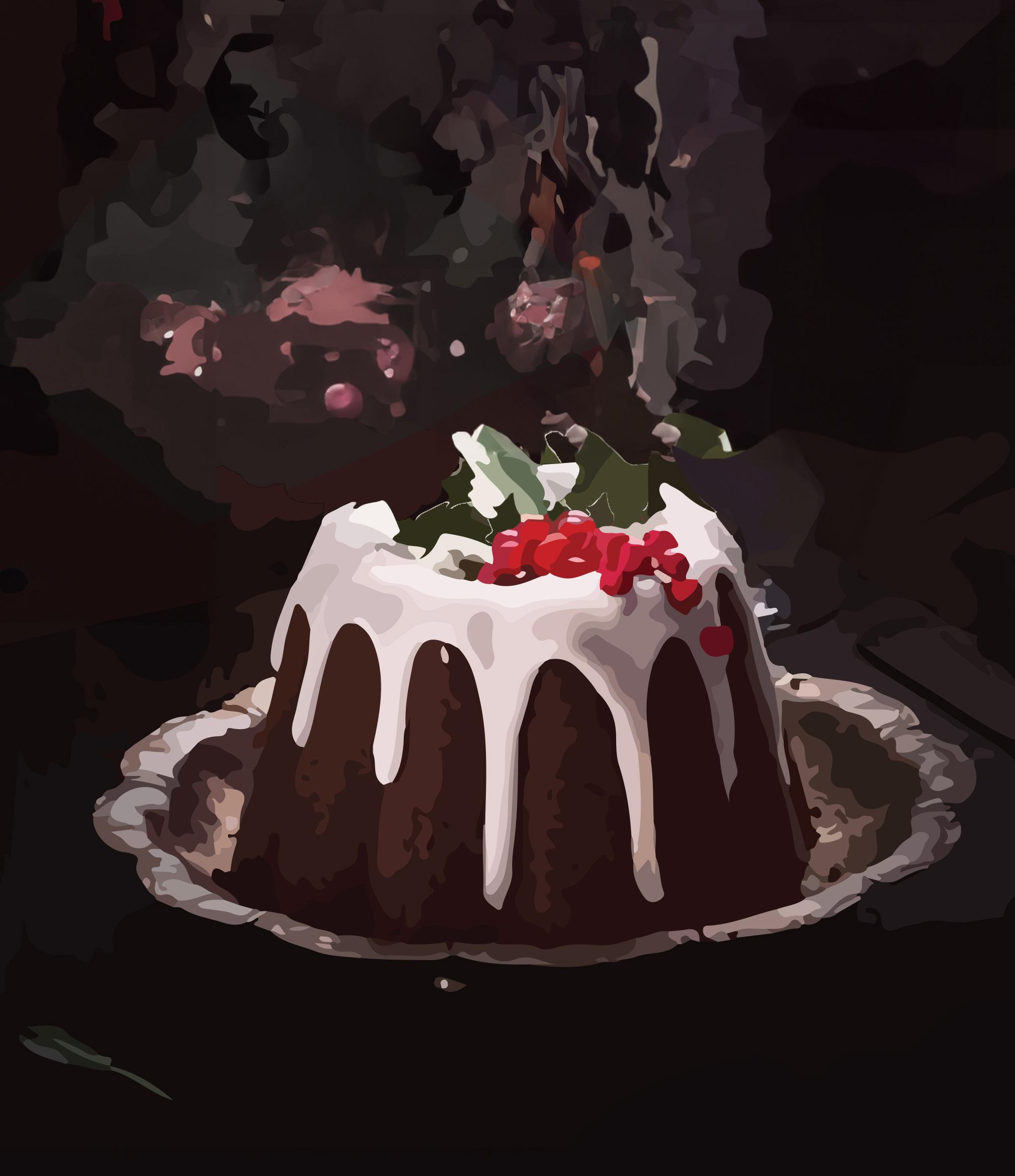
Reclaiming Christmas Pudding
CONTENT WARNING: EATING DISORDER
!
Feature
06

of the celebrations is a great source of joy for me,"
as are most of the relationships I engage with over the festive period. Despite this, I do maintain one relationship which I find an unfortunate source of great anxiety. This relationship is with food.
I have been receiving treatment for the binge-purge anorexia subtype for over two years and have experienced two Christmases in that time. Despite their misleading name, eating disorders are control mechanisms at their core, as opposed to solely being a food fixation intertwined with a desire to lose weight. Similar to other self-destructive behaviours, eating disorders arise as a means of managing internal conflicts through becoming numb and desensitised to emotional distress.
by my family members in appreciation of each individual contribution to the Christmas Dinner, and their sense of togetherness celebrated by indulging on it. I also engaged in this superficially, but proceeded to detach myself from the more meaningful connections when I left the table to throw the fruits of our labour up into the bathroom toilet.
Whilst my eating disorder serves to separate me from my emotional distress, it also hinders my experience of positive emotions and creates an otherness between myself and my family. My mood swings mirror my irregular endorphin release as dictated by the binge and purge cycles, and my general irritability by my malnourishment. My family have been unaware of my diagnosis over the last two years, but they could deduce that I was struggling to some extent.
The Christmases restricted by my eating disorder have tampered with my temper, which my family found difficult to navigate whilst I kept them in the dark.
Feature 07
Design: Katy Blair
Words: Anonymous
The socialisation, emotionality and food-oriented components of the festive period often serve to widen the stark divide my disorder has created between me and my loved ones. In solemn reflection of the past two Christmases, all I feel is guilt for creating this disconnect at a time where community is supposed to be celebrated. It is easy to spiral into a thought process where I hold myself completely accountable for my disorder, but I’ve come to realise, through extensive therapy, that the situational odds of developing healthier means of addressing my emotions really were working against me. Rather than dwelling on the “ifs” and “buts” of the past, I want to instead focus on how I, and those around me, can create a more accommodating festive environment.
It’s fair to say that food cannot be avoided during Christmas, be it as a subject of the senses or that of conversation. Supermarket shelves stocked up with minced pies, chocolates, and sausages as early as November expose the starring role food plays in the festivities. In addition to this, the considerations of food are magnified in my
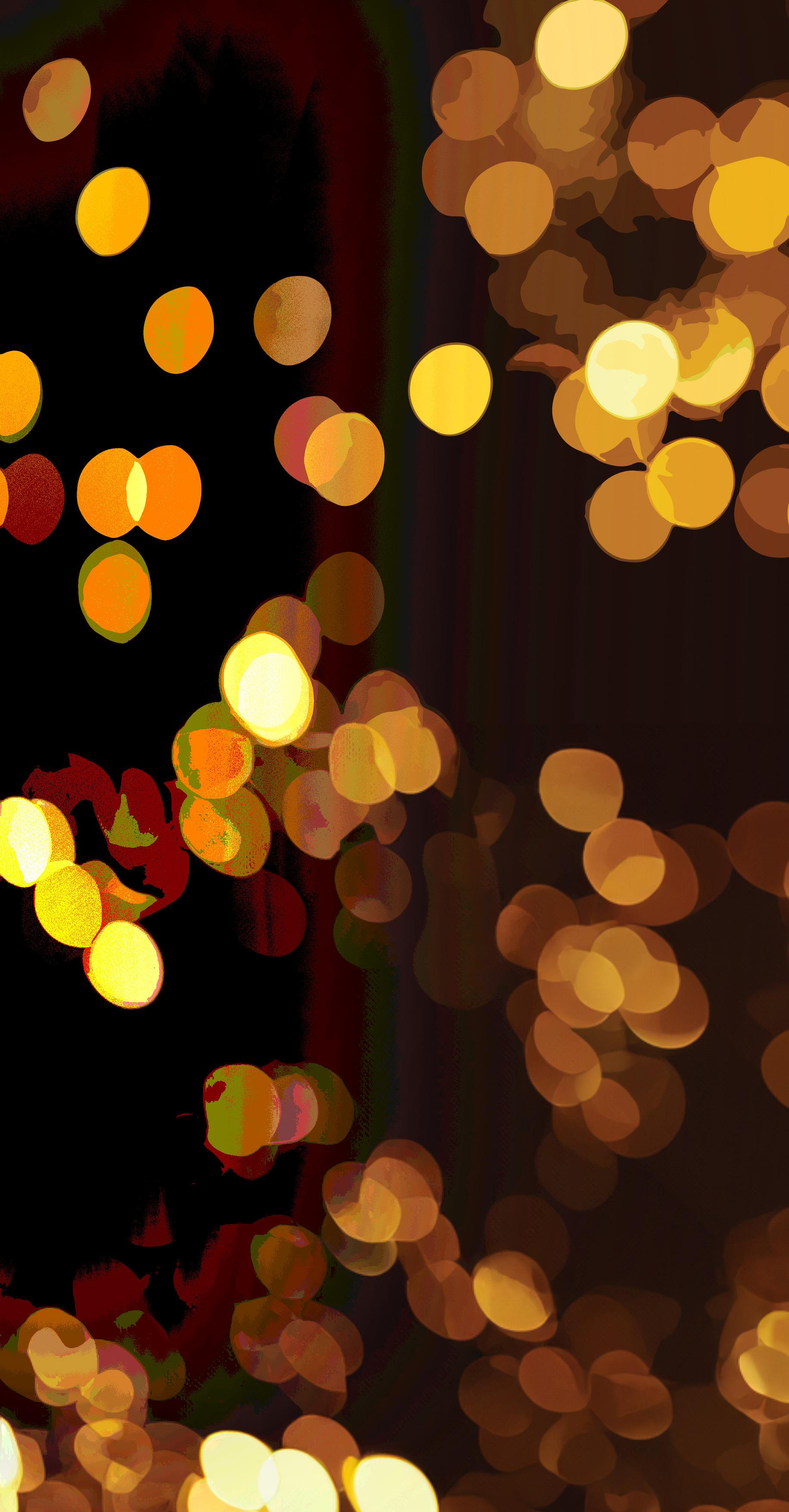
08 Feature
Christmas music, games and movies can function as good distractions from anxieties surrounding food and eating disorders. The topic is bound to come up more frequently at this time of year, but offering some form of escape from the conversation can make it more palatable. A time that I have found the greatest need for this is the couple of hours directly after eating, when purging tendencies are at their strongest. Having a board game or afternoon stroll lined up can at least attempt to keep these urges at bay. I understand that laying down a script for the day and avoiding certain conversation topics can present itself as a killjoy’s approach to Christmas, and it is something I wish I didn’t have to do. I have honestly considered spending Christmas alone this year to avoid unloading my burden onto my family. I know however that this option would hurt my family more, and so I am trying my hardest to compromise.

As I write this article, I am on an eighteenday streak of not making myself sick which is the longest I have managed for over two years. This isn’t as long as my Duolingo streak, but it’s an achievement regardless. I am not going to jump the gun and consider myself “cured”, but I am in a marginally healthier place than I was a month ago, and an immensely healthier place than I was a year ago. Christmas will be difficult and triggering, but articulating my concerns and navigating some solutions through writing this article has helped. Eating disorders only have as much power as you give them, so don’t give them the power to taint your festivities.
Feature 09
Design: Katy Blair
Words: Tommy Gachagan
A New Radical: There Are ‘. . . But New Suns’
Dear reader, what you now hold in your hands is my review on the new exhibition by the Otolith Group. However, I don’t like addressing it so. You are therefore about to engage with my thoughts and feelings about ‘…But There Are New Suns.’
On the 12th of October, I was invited to the Cooper Gallery to see the new exhibition prior to its opening that very evening. ‘…But There Are New Suns’ is the third chapter out of five of the critically acclaimed exhibition and event project series, ‘The Ignorant Art School’ by The Otolith Group. ‘The Ignorant Art School’ is the Otolith Group’s first solo exhibition in Scotland - held in DJCAD’s own Cooper Gallery. The exhibition feels and acts like an educational space. A variety of
resources and books are made available, touching upon what the group was inspired by. These reveal inspiration coming from different forms of education and studies from around the world. I was personally extremely interested by the project’s name (“The Ignorant Art School”) which, along with some of its themes, was inspired by Jacques Rancière’s book, The Ignorant Schoolmaster: Five Lessons in Intellectual Emancipation. Rancière is a philosopher I thoroughly studied in one of my Philosophy modules and one I enjoyed reading. Key to the exhibition is the research and exploration of new avenues for both art and education.
It would be impossible not to argue that the Otolith Group are quite a political
Arts & Entertainment
10
group. They, in fact, came up with their name to avoid their identity being questioned. However, this doesn’t mean their identity can’t and isn’t being explored. As already mentioned, this project is intended to find new routes for art and education, one for Afro-Asian solidarity especially. Solidarity is a key theme throughout this exhibition. In my opinion, for example, it is the key message of their film ‘What the Owl Knows’. We follow the artists as if we were painting with them and joining them on their journey. This was also done to put a stronger focus on the art itself. Additionally, the film includes an excerpt from RMT General Secretary Mick Lynch speech which only cements its themes of politics and solidarity.
‘What the Owl Knows’ was key to the exhibition as it took up a significant amount of space and was a highlight of my experience. I loved the ambient and urban aesthetics of the soundtrack, almost akin to music concrète. This was perfectly contrasted by the sounds and images of nature, of an owl especially. The soft-spoken narration felt like a teacher reading a story to their classroom, further enhancing the idea of an educational space.
During the exhibition, I found myself starting to feel the existential dread of a dystopian world as I listened to excerpts from UK Conservative party members and MPs speeches. The chosen extracts discussed things which I truly find awful. It made me ponder on the way politicians look down on us making us feel like we are inferior to them, like we’re “scum.” Considering it’s coming from the Tories; I would say it is quite ironic.
Peter Amoore, the Curational Assistant from DJCAD, was extremely helpful throughout my visit. He provided me with useful background information about the display such as its role in challenging the meaning of art education. The exhibition already shows its radicalness by occupying spaces of institutions with a colonial past and ‘…But There Are New Suns’ is their third ‘sit-in.’ Furthermore, unlike many radicals who neglect practice in favour of theory, the group encourages the former too by, for example, use of radical language. One section especially felt like an educational space as its resources relied on books from Marxist (as well as other philosophers) and anti-colonial writers, a core theme of the exhibition.
This was my first time attending an exhibition by the Otolith Group, and I very much enjoyed my experience. I would like to thank the Cooper Gallery for inviting me and the Magdalen editorial team for providing me with the opportunity to experience something new for the first time. I highly recommend people attend the Cooper Gallery exhibition as well as other Otolith Group displays. However, if you consider yourself to be a conservative, I would avoid it unless you like your political views being challenged. I look forward to the final two sit-ins of the ‘Ignorant Art School’ series and would love to attend again, either from a journalistic perspective once more or as a regular visitor. I am abstaining from rating the exhibition as I believe that it would cheapen my experience and undersell how good it was. To conclude, I would invite you to go to as many Otolith Group exhibitions as you can. Keep an eye out for them in the future, you really don’t want to miss them!
Arts & Entertainment 11 Design: Fiona Howard
Queer Orgies Blessed by Lord
CONTENT WARNING: STRONG LANGUAGE & SEX
Having spent July at a lively outdoors handson community-run educational team building exercise, I needed a recuperative break and decided to attend Queer Spirit festival with my dear hot Northern English 1960s wife. Between my epilepsy and her high maintenance, we decided to book a room rather than camping out. The very friendly pub hotel was much better than what my childhood-informed prejudice against Devonshire villages expected; Uffculme’s leftover post-Coronation Union Flag bunting was cute and charming, like Christmas lights in February or Free Derry murals.
Led by the Radical Faeries, Queer Spirit’s fourth outing was a delightful, deeply welcoming experience. The almost camp pagan spirituality of the ceremonies allowed even the more curmudgeonly types to join in with a true sense of communion, of diverse individuals consciously coming together. Materialist cynicism is hard to maintain when a wizard invokes the destruction of the planet that humanity is causing and then proceeds to bless the fire we are dancing around. Going with the flow is the key here.
Bards, druids, hippies, punks, naturists, painters, gender oracles, musicians, sex workers, anarchists provided a fascinating array of educational workshops, discussions and events. We discussed founding that queer commune so many of us dream of, queer land working, radical relationships, what it means to be cisgendered and queer – the kind of things modern day university should be about. The festival provided many opportunities to connect on both light and deep levels, with healing circles, speed meeting, semi-naked wrestling and bonding over the shared experience of pissing in a hedge whilst massive-antlered deers watch.
Entertainment ranged from sound baths to cabaret (“You might have watched Drag Race on TV / But that’s not gay enough for me”) and

the musical offerings were eclectic. The wife’s shyness was abandoned when she heard the call of her people, gay punk rock. She departed for the mosh pit while I prayerfully walked to the Temple.
Distortion by omission is a favorite journalistic technique. I enjoyed Tatler’s Chandler Tregaskes whose article revealed that “the Sacred Sexuality Temple offered deeper thought-led discussions and seminars”. To quote former Dundee MP, amphetamine enthusiast and much-admired war criminal Winston Churchill, this is a terminological inexactitude.
Perhaps Tatler wanted to spare blushes by depriving readers of details of the orgies, which for me exemplified the “unbridled sense of
Words: Tánaiste Arts & Entertainment 12
!
Illustration: Henri Matisse, Design: Douglas Pascal
Lord Mountbatten’s Wild Deer
note – making your events, whether at Freshers or elsewhere, more accessible for neurodivergent people will benefit everyone. Perhaps a Neurodivergent Society run by people who are, I don’t know, neurodivergent? Anyway, I digress.
As someone whose kinky boots go with a lovely khaki suit, it’s not my usual habit to praise a Lord Mountbatten. I must credit him for his generous hosting of us and for being a decent normal human being happy to talk to folk. His daughter and her straight friends were also lovely and a nice reminder that cishets are valid and, in some situations, perfectly accepting. Personally, I hope this is the beginning of his transition to full class traitor – perhaps next time I piss in his cafe urinals I’ll be watched by something other than a signed photo of noted pro-AIDS activist Ronald Reagan.
Jokes aside, Queer Spirit has been one of the most sincerely lovely LGBT gatherings I’ve been part of. I’d particularly recommend it to those of us who have experience of finding we don’t quite click with some queer spaces. Alas, they seem to be biennial at this point – it takes a lot of organising and the dream of a spiritual queer community festival is manifested through love, volunteering and last-minute panics. Perhaps there’s space for a wee Scottish gathering in 2024?

community and love” the festival created. (Hey, Love Society, I’ve got an idea for a future event). Where else can you watch dozens of fellow queers soberly pretending to be bonobos whilst fucking? I decided this was the moment to listen to my current Evangelion, Komm süßer Tod obsession on my headphones. Voyeurism is participation and perhaps even a form of meditation (“Dear Ajahn, I have an idea for a meditative practice...”).
Speaking of participation, there were a lot of us spectrum-y people about, so my offering was to lead a discussion group on neurodiversity at Queer Spirit. We provided many ideas around accessibility which would be of use not just to our people but that would be of universal benefit to the entire festival too. Universities, take
13 Arts & Entertainment
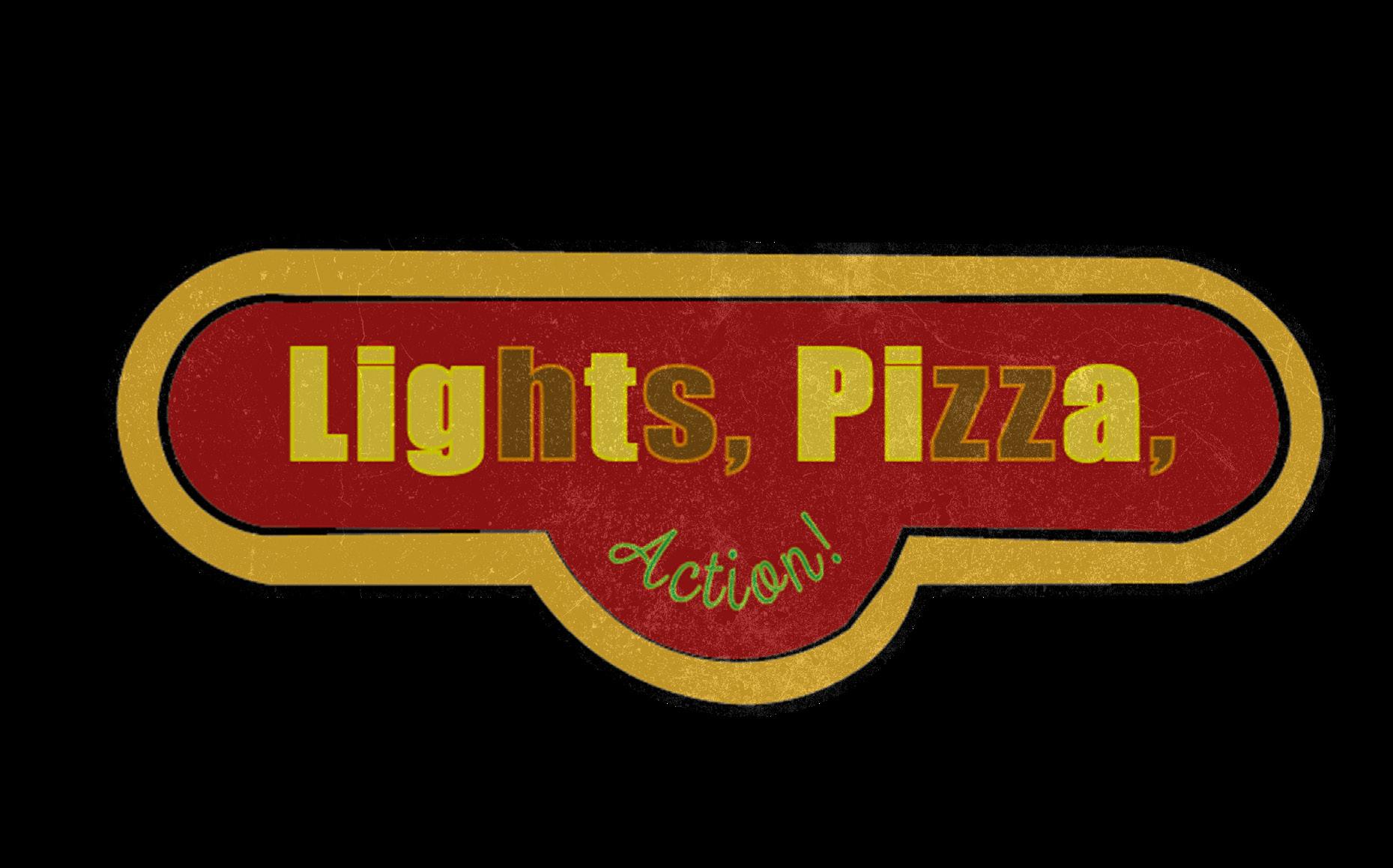
The FIVE NIGHTS AT FREDDY’S: THE MOVIE Reviewed
Expectations for the Five Nights at Freddy’s movie were mountainous due to its hectic eight-year development, which witnessed countless shredded scripts and studio changes. The film was eventually released in 2023 with an impressive box office opening. For those who are unfamiliar with it, Five Nights at Freddy’s (FNAF) is a videogame franchise set in a haunted Chuck-E-Cheesestyle pizzeria, ‘Freddy’s.’ Players must survive five nights in the restaurant, fighting against animatronic mascots determined to slaughter them. But does the movie live up to the hype and horror of the games?
In the movie, Mike Schmidt is employed on the night shift at Freddy’s to guard its…well, “inhabitants:” the animatronics Freddy, Bonnie, Chica, and Foxy. These anthropomorphic robots initially come across as friends until they reveal themselves to be haunted by the ghosts of dead children. They are brainwashed to take the lives of anyone who is a danger to the pizzeria and to kidnap

Arts & Entertainment 14
children… it’s pretty barmy, but hey, at least the lore is less complicated than the games! As a videogame adaptation, FNAF is true to its iconology. The animatronics, predominately created through practical effects, look exactly like their videogame counterparts. The pizzeria itself looks the same as in the game and it is packed with enough ambience and easter eggs to make your average FNAF fan drool. As a horror experience, however, the film doesn’t live up to expectations. Let’s face it, if the movie had Mike sitting in his closed-door office for six hours for five nights it would be rather boring. But at least it would have encouraged tension, which the movie generally lacks. The main plot follows Mike dealing with the kidnapping of his little brother (which may be linked to Freddy’s pizzeria - it’s not clear) but it does not look like a life-or-death situation. Furthermore, the animatronics are unthreatening, and for a franchise that became popular for its jump scares the movie has very few. So, while all of the visual

elements of the game are present, the movie fails to live up to the same experience of tension and unexpected terror. Horrific ideas such as the vengeful spirits of dead children are implied, but the movie barely builds upon them.
These critiques, however, do not prevent the film from being an amazing-looking adaptation. The visuals make you want to watch more and remind the audience of why gamers love this manic, convoluting franchise. This praise perhaps helps the average “film score” that drops when it comes to its plot. But again, did audiences really expect everything to make sense? This is Five Nights at Freddy’s we’re talking about… Overall I’d give it a 6/10.
Section Title Here 15 Design: Jasper Napier Arts & Entertainment
Words: Clare Havertape

I’ll Be Home Soon I’ll Be Home Soon
Dear Mum,
There’s a surplus of struggles I’ve tried to overcome for the sake of happiness, but I’m afraid my achievements on that front haven’t amounted to much over the past years that I’ve spent away from you. That is not to say they are nonexistent, however. I only mean to say there are some nuances I wish could be eradicated to bring you and me closer again like we were before I moved away.
Distance is much of an issue. Six thousand miles is quite the difference when compared to what it was before: a couple meters down the hall from my bedroom to yours.
I go into my kitchen in the mornings and there is no pot of coffee waiting for me on the counter, the comforting scent of a dark roast does not waft through the air.
I look into my living room and there’s no opened books on the side table, nor is there a newspaper lying on the couch half-read. I know you like to keep up with the latest stories, and I sometimes feel guilty that I am not in constant contact with you so we can continue our own together.
It seems that when I moved away, half of my life ceased to exist because you were the one creating it. The story of life was yours, it was your world, and I narrated it— but you were always the focus, the heroine.
Creative Writing
16
Soon I’ll Be Home Soon I’ll Be Home Soon
You were always the one to sacrifice, and still are. Audiences always want to hear and read of those who sacrifice because without these characters, one wouldn’t feel inspired at all to be like that. We need these characters and virtues to be able to keep gratitude flowing through the world.
I miss you, Mum. And now it seems I have to put in double the effort to pretend like you’re there, and that makes me afraid too.
Sometimes I wish I never moved away, but it makes those short moments where we do get to see each other even more memorable. And in each of those moments I cherish the way I

love to be hugged, given a cup of peppermint tea, and told how much you’re proud of me. But I’ve merely been watching you so I can learn to live and stay resilient; and above all, love the way you loved me up until this present second and for forever afterwards. I cannot wait to see you soon.
Love, your daughter.
Creative Writing 17 Design: Joshua Harris
Words: Lara Luyts

Gentle Fireworks
A slow song flows from the speakers, volume low. The singer’s voice is familiar, even when the song isn’t. We still have over an hour before we need to leave, so I take my time as I press colour onto my eyelids, the tip of my index finger stained a sparkly blue.
You compliment the colour. I smile.
Outside the sanctuary of my bedroom, people are laughing. Drunks yell at each other, and the bar on the corner of the street plays music with a bass so heavy my windows shake with it. All of it is muffled now, but soon enough we will become part of those celebrations, pouring drinks and joking around.
I ask how you’re feeling, knowing that you prefer quiet nights. Your hand on my chin makes me look up, just to see you roll your eyes at my concern. “It’ll be fun,” you repeat my own words back to me. Not exactly an answer to my question, but I can tell that you’re sincere.
Once I finish my make-up, I get us two glasses of wine. You accept one gratefully, but before you can put it to your lips, I raise mine. “To us.”
Smiling, you shake your head. “Shouldn’t we be toasting to the new year?”
“Alright, then. To starting the new year together.”
You don’t try to correct me again, just keep shaking your head as our glasses clink against one another.
. . .
I almost stumble while pulling on dark tights, tipsy from wine and excitement. It would be a lie to say I haven’t been looking forward to this – our first New Year together. Sure, Christmas last week was a big step as well, but that’s different. We spent it with my family, and though we had fun there was a sense of relief as soon as we got home again. You relaxed completely for the first time all day, and in the privacy of our home we exchanged gifts.
Tonight there are no distant cousins to entertain, no nosy aunts that somehow manage to ask all the wrong questions. It’s just us and a small group of friends, a family we picked ourselves, who we have the liberty of being completely ourselves with. There’ll be games you will undoubtedly win, memories recounted through laughter, and songs that we’ll shout along to. Through it all, I know there’ll be that familiar warmth in my chest, the kind of happiness one can only find in the company of others. We’ll trail behind our friends, hand in hand, and watch them hunt for the best spot to watch the fireworks.
Creative Writing
18

19
Creative Writing
Design:
Heidi Le
Words: Ren Jakab

I’m not your friend. never have been, never will.
I’m just your fool who trails after the breadcrumbs you throw my way.
I’m not your friend. I’m Hansel or Gretel, but this fairy-tale doesn’t end well, I get burned by you, like forest fire raging on wood and dry air.
I’m not your friend, I held you under my gingerbread heart, and begged you to take a bite, to take the risk. You broke it in half.
Creative Writing 20

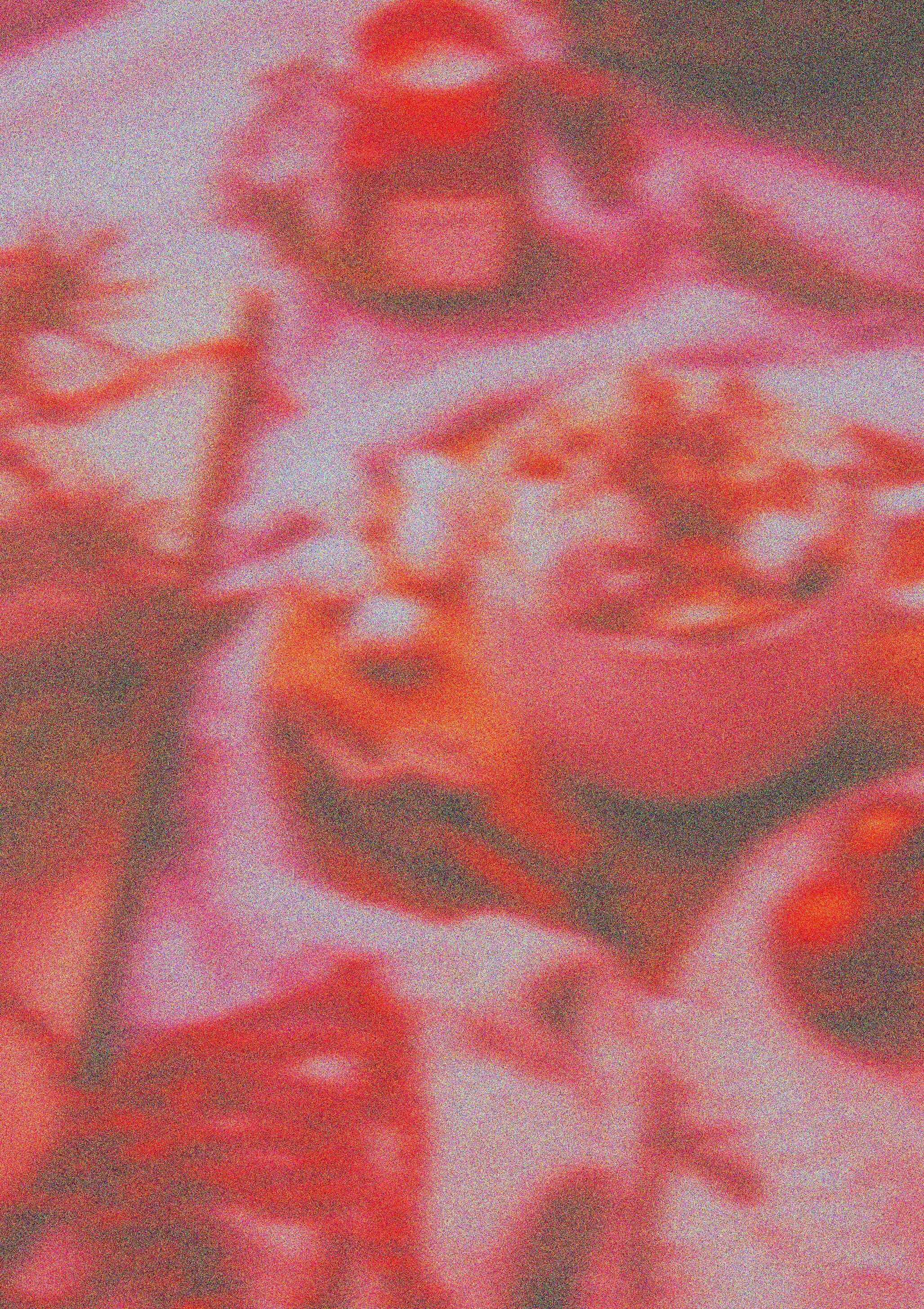
Creative Writing
21
Design: Heidi Le

Words: Archer Roehrig,

Sieging you with shame.
An Apology, a Thank You Note, a Love Letter !
CONTENT WARNING: MENTAL HEALTH ISSUES
I’m sorry I can’t look at you when I say it
‘Thank you’
I’m worried if I looked in the horse’s mouth, I’d somehow break its teeth
Worse,

My hand’d pass through its mass, Translucent. I’d dreamed it.
Anthrax coated gift wrap searing holes in my hands
I can stare through to the floor
I do.

I’m Satan, One bound brings me over the wall, I race to you to confess my sin, Slithering self-flagellating sobbing at your feet, Where you stand by the open gate, Waiting to let me in.
I’m sorry,
Thank you, Weights on a scale you never comprehend Instead, You pry the balance chain by chain from a hangdog head.
Treasuring me is tedious detangling

I can’t look up anymore
I ache.
I’ll never look up from the floor
Opaque.

I adore you too much to look at you
Thank you.
I love like a balance.
Themis holds me by the scruff
Pathetic, penitent puppy
Every apology you dismiss, Teaching me when gratitude is remiss, What did I do to earn you?
What can I do in return?
I confess that we will never be level You remind me what makes us even.
Please,

Lock the gate to Eden till I recall the magic words I’m sorry. I forgot
Thank you. For still letting me in

The chains of her scale tangle round my neck, Its beam bolstered by slumping shoulders A yoke.
She shakes her head
I wonder what I owe her.
Over and over

I wind up suspended
Whenever I quest for Venus.
Walls of unworthiness between us, Me outside, and You in Eden.
I hurl ‘thank you’ in a trebuchet,
Themis can kick me out until I finally get it right.

Meet me outside the door, I’ll say what I meant before With assurance overdue: I’m sorry I mean,
Thank you
I mean, I love you.



Agne Irbe Creative Writing 22
Design:

Darkness moves in quickly now; a thick, heavy blanket that lays itself over the house with small slivers of fire-like light that seep through the gaps in closed curtains, warm hands that pull the blanket tighter throughout the bitter nights. Inside, the fireplace whistles and dances, the television, muttering out the thousandth retelling of Elf is left ignored and forgotten; the kitchen buzzes with activity, food being prepared at a snail’s pace in between conversations and bouts of rumbling laughter that push at the kitchen’s walls, accompanied by the applause of plates thudding down onto the counter, dishes clattering into the sink, the roar of an eager oven.
Across the hall, a bedroom transforms into an orchestra hall; in front of the crooked music stand propped up against a wardrobe stands the lead violinist, clad in fluffy slippers and oversized pyjamas. Their fingers ache and their arms burn from holding their instrument upright for so long, diligently playing the same song again. Short fingers strain over the neck, shakily jumping from string to string, rushing to their place before the bow can pull the note from it.
Words: Rowan Clark, Design: Marie Pape
Silent Night in C Major



A trembling tune begins anew, playing to a beat of its own, sprinkled with its own notes in a creative twist. Again and again, sometimes steadier, sometimes reminiscent of the song it is meant to be.
A knock on the door breaks the illusion; the stage melts away and the bedroom returns. The echo of the song sinks into the floor and the walls, and the smell of freshly cooked food fills the house. The instrument settles, propped up against the wardrobe, sparing its audience for the night, keeping them on edge for the next performance.
It is dark and November again. The song, out of tune and played at the wrong speed, somehow didn’t sound so bad back then.
The cold settling into the ground didn’t quite reach through and the approach of Christmas loomed over everything, grand and exciting. Rewatching Elf with everyone with the shaky tune of Silent Night ringing in our ears seemed, at the time, to be one of the best nights; still, it echoes in my ears, off-putting and fond, and what I wouldn’t give to play it badly again; to be a small star on a bedroom stage and to feel so grand on a cold night.
Creative Writing 23
Creative Writing 23
Words: Tom Christison

BONFIRE NIGHT TERROR
“Remember, Remember...”
On the 5th of November 1605, the Gunpowder Plot was foiled. Guy Fawkes, a man determined to blow up the Parliament, was caught in the chambers below Westminster with 36 primed barrels of gunpowder. He was arrested and executed, and the Parliament was saved. Since then, the 5th of November has been celebrated annually with fireworks displays and bonfires to revel in the foiled plot to destroy the parliament and the monarchy. However, recently the celebration of Bonfire Night has been called into question as anti-social groups have taken it as an opportunity to cause disruption, putting strain on health services and police.
Last year, riot police were called to Dundee to deal with anti-social behaviour in the Kirkton district which saw mass damage to property and disruption of public transport; shops were also broken into and stolen from. Fires raged in the middle of the streets and violence occurred between youths. This
caused the number of officers on patrol this year to dramatically increase, but it does not seem to have deterred further incidents. This disruption seems to have become annual as this November 5th police were attacked with bricks, with two patrol vehicles being the primary targets. This follows a pyrotechnic display of terror on Halloween night where roads were blocked with flaming bins, cars were smashed, and schools were vandalized. The behaviour has been deemed ‘reckless’ by police.
This year, police were also called into the Niddrie district of Edinburgh where youths numbering around 100 unleashed fireworks against private property such as houses and vehicles – riot police were quick to attend the scene, armed with shields and protective clothing. The youths began to target them with fireworks and petrol bombs. This follows a similar incident last year, where members of the public were targeted with fireworks, and a Molotov cocktail was launched at a police vehicle. These assaults both resulted in cordons and roadblocks and have laid a precedent for further action to be taken in
24 Current Affairs

the future. First Minister, Humza Yousaf, has called the event ‘disgraceful.’ In Glasgow, it was stated that rival gangs clashed resulting in violent injury to many whilst embroiled in the seemingly Scotland-wide Bonfire Night anarchy. Between incidents in Scotland, there have reportedly been eight injured police officers working the nights of disruption.
The Firework Campaign in the UK was started in 2013 to limit the availability of fireworks; it campaigns for introducing a licence to purchase fireworks. In 2021, a petition supporting the campaign got over 100,000 signatures and thus the parliament was forced to comment. Fireworks are considered a public danger due to their ability to burn, maim and kill. Yet, the Parliament – who are heavily familiar with the long-running debate over fireworks –have not seen fit to place restrictions on who can buy them (aside from having to show proof that you are above 18 years of age to purchase). Public use of fireworks states they can be fired 16 hours of the day every day. Thus, we expand the conversation from antisocial behaviour to safeguarding vulnerable groups as part of the wider fireworks debate.
To many, the sudden boom of a firework can be triggering and dangerous, such as to those with heart conditions, PTSD, mental difficulties, or the infirm. This is why The Firework Campaign works to change legislation regarding fireworks. Fireworks can not only cause human fatalities but this year, as heavily reported, a firework was set off next
to a field and resulted in the death of farm animals. Physical injury is also common from faulty fireworks or misuse, causing there to be a spike in burn-related injuries on Bonfire evening.
To return to the waves of anti-social behaviour across Scotland, the police plan to retaliate by increasing working numbers on Bonfire Night and the period surrounding it, as well as banning certain stores in Dundee from stocking fireworks. The strain on fire, police, and health services continues to worsen annually, and now many question if Bonfire Night is worth commemorating at all. This night of terror, brought on by a minority determined to cause panic and terrorise neighbourhoods and cities, has created one of the longest nights of the year for emergency services; indeed, ‘Operation: Moonbeam’ was set up by the police in 2018 to combat unrest around the period of Bonfire Night, but now officials are calling for tighter rules and law enforcement to help protect the streets on Bonfire Night.
On a night celebrated commonly by burning a figure of ‘the Guy’ it is easy to see how acts of anarchy and violence have become an ugly tradition. Ideas of decorum are often mentioned when Bonfire Night comes to mind, but these events have proven that decorum and explosives do not mix.
25 Current Affairs
Design: Rachel Middleton
David Cameron: Our Cheugy Foreign Secretary
Society has always had a complicated relationship with its
recent past. In the 1960’s counterculture, the worst thing you could be was from the 1950s. For the punks, The Beatles were the worst kind of cringe. And for us millennials, the brief popularisation of the term ‘Cheugy’ - used online to mean ‘early 2010s cringe’was a bitter pill to swallow.
Were we that bad? Are Yolo, Celebrity Juice and TopShop so off-putting? We got a blast of 2010’s nostalgia on 13th November when, in the reshuffle following the replacement of Suella Braverman as Home Secretary, it was announced one (soon to be Lord) David Cameron was appointed as Foreign Secretary.
The younger amongst us probably don’t remember the meteoric rise of Dave Cameron in the 2000s. Gone was the old Tory party full of reactionary fuddyduddies. This was Liberal Conservativism: pro-gay marriage and based on common sense. We were urged to “Hug a Hoodie” and the Daily Mail warned of the “Death of Thatcherism.” What you will remember is
Prime Minister David (not Dave) Cameron. The old Etonian who closed the community centres, cut benefits, capped nurse’s pay and might have done something to a pig we can’t print here. Far from hugging hoodies, Britain responded to the 2011 riots with night courts, sending teenagers to prison for stealing chocolates. The coalition government was characterised by brutal austerity and slogans like “Keep Calm and Carry on”Cheugy indeed.
“for us millennials, the brief popularisation of the term ‘Cheugy’used online to mean ‘early 2010s cringe’ - was a bitter pill to swallow.”
The later career of Cameron is marred in controversy: picking the wrong horse in the 2016 referendum and seeing old mate Boris Johnson outdo his majority in 2019. During the pandemic, he got a gig lobbying for something we cannot legally call a scam: Greensill Capital. Targeting then-chancellor-now-PM Rishi Sunak and Michael Gove on behalf of founder Lex Greensill. Greensill Capital collapsed and took a lot of people’s money with it. The Financial Times had reported Cameron had sent a lot of very matey text messages urging ministers to invest public money. Multiple instances of double texting were left on read. Each message ended with “.DC”.
But just what does the return of Dave (DC), that most cheugy of omens, portend? Is Britain planning to bungle an intervention in Libya, or fail to gain support for an airstrike on Syria? There is no way to know. I wonder if, when shuffling the deck chairs on the Titanic, the staff considered wheeling out an old, busted threepiece settee.



Current Affairs
Words: Liam McClurg, Design: Douglas Pascal
26

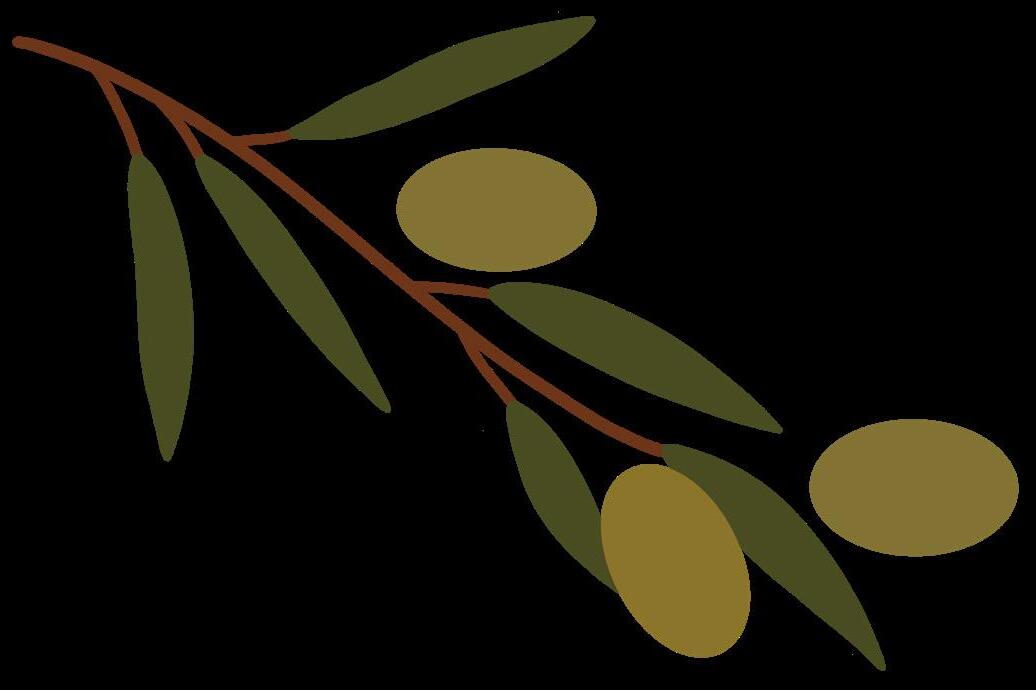


Words: Molly Wilson, Design: Ayla Ahmed
Palestinian Journalists: The Saving Grace of Information

under rubble that used to be their homes and then seeing an ad for Starbucks’ new drinks menu.
Since the 7th of October, 35 Palestinian Journalists (Committee to Protect Journalists, 2023) have been killed by Israeli bombs. There are many Palestinian journalists present on social media platforms that are reporting on the active genocide happening to their own people and on their homeland. Some of these journalists include Plestia Al Aqad, Motaz Azaiza and Bisan Owda.
As most of the world has access to social media and online resources, we are the first generation to be able to connect with the victims of war and genocide. We have never before been able to connect with these people on a personal level. We are sympathising with Plestia Al Aqad while her home is being carpet-bombed beyond recognition. We are understanding Motaz Azaiza’s person while he mourns fifteen martyred family members. We look to Bisan Owda’s Instagram profile for information while she starves. We are living in an Orwellian world as we get the indispensable information to educate ourselves while the people reporting on this horror are dying. There is something incredibly nightmarish about scrolling on phones looking at children crying for their parents buried
Shireen Abu Ahleh was an AmericanPalestinian journalist who was killed in 2022 during a raid on the Jenin refugee camp in the Israeli occupied West Bank of the Gaza Strip. There are now dozens of Shireen’s. Bisan Owda was a filmmaker before the destruction wrought by Israel, she now starts her videos with, “Hey everyone, this is Bisan from Gaza, I’m still alive. So far.” Hind Khoudary, another Palestinian journalist, was given the chance to leave for the Philippines with her husband but chose to stay with her mother and brothers in the Gaza Strip. The selflessness of these acts is unthinkable to people living free from incessant bombardment.

It is pertinent to ask, where are the big news broadcasters in this time of terror? BBC have recently taken six reporters in the Middle East, including Lebanon and Egypt, off air for pro-Palestinian activity on social media platforms. How are we supposed to trust our media sources when they do not allow journalists to report freely? When they leave people who are just trying to survive to take up the roles of multi-billion-pound broadcasting companies.
There is something very dystopian and Hunger-Games-esque about watching, mostly young, people dying through our phone screens while our governments turn away from the cries of the murdered.
Current Affairs 27
Words: Mona Eckle, Photography: Heidi Le, Design: Luna

Instant Holiday Bliss in a Mug: Gingerbread Mug Cake
Embrace the holiday spirit with this quick and easy recipe designed for busy students. In just a few minutes and with minimal ingredients, you can treat yourself to a warm, spiced delight that captures the essence of Christmas – the perfect way to infuse your day with festive joy!
Ingredients
3 tbsp flour (heaped)
1 tbsp (brown) sugar
½ tsp baking powder
½ tsp cinnamon
¼ tsp ginger
Pinch of salt
½ tbsp oil or melted margarine
6 tbsp milk of choice
Optional: vanilla extract, chocolate chips
Note: depending on the size of the mug, you can double the ingredients.
Instructions:
Add all the dry ingredients into the mug, then add the wet ingredients and mix well. (For a cleaner finish, add to a bowl first and transfer to the mug after mixing.)
Microwave for 3 minutes at 700W.
Let chill for 5 minutes, add optional toppings and enjoy!
Optional topping ideas:
Powdered sugar + cinnamon + cocoa powder
Icing Vanilla ice cream
Whipped cream
28 Lifestyle
Jezzard
Words: Roshni Baillie, Design: Fiona Howard
Easy Chocolate Orange Fudge
The cost-of-living crisis a great excuse to skip out on getting people Christmas gifts, but now you can whip up a batch of fudge, slap a bow on top, and rest easy in the knowledge that your place is firmly held on Santa’s nice list.
Ingredients:
• 3 chocolate oranges
• 18 mini chocolate orange segments
• 1 tin condensed
• milk (397g)
• 80g icing sugar

Pour condensed milk into a pan and add the chocolate orange. Melt over a medium heat until the chocolate is completely melted.
Add the icing sugar and beat until well
Pour into a lined tin, no bigger than 20cm, and press the mini chocolate orange segments into the top.
Leave to set, chop into squares and enjoy!
Lifestyle 29
Words: Eshar Bola
Love and Relationships
“
I have a new boyfriend and my best friend hates him. She thinks he is controlling and doesn’t like that we don’t hang out as much as we usually do. I don’t want to break up with him, but I’ve been friends with my bestie since high school, what should I do?
Dear reader,
There seems to be a lot to unpack here as there could be multiple reasons for your friend’s behaviour. It sounds like you value both your boyfriend and your friend staying in your life, so I think it is important to get to the bottom of your friend’s feelings.
Firstly, I wonder why she thinks he is controlling and whether there is any merit to it. Sometimes it’s easier for friends looking in on the relationship to notice a partner’s possible ‘red flags’. I think it’s critical to ask yourself whether your partner has exhibited any of these behaviours, both to rule it out and for your own mental health. However, you also mentioned that you haven’t been able to hang out as much. This may have led your friend to believe that your boyfriend is isolating and controlling you. I completely understand that you want to spend all your time with your boyfriend when you start a relationship because it’s new and exciting. It does seem like you still want to maintain this longstanding friendship though, so you may need to be more conscious of spending time with your friend as well. She may just be feeling a bit left out and secretly jealous, resulting in her animosity towards your boyfriend.

but still disagree. You don’t and shouldn’t have to choose between breaking up with your partner and staying friends with your bestie. Life, especially relationships, are all trial and error and no one has everything figured out. As long as you can live happy with your decisions, stay with your boyfriend, although your friend may just be trying to protect you so also try to communicate with her to maintain your friendship.
Lifestyle
30
“
 Design: Fiona Howard
Design: Fiona Howard
Time Management and Deadlines
I have been really stressing about my deadlines. They are all piling up and I still have societies that I’m committed to, and I don’t want to miss out on the uni experience by spending all my time in the library. I’m not sure how I should be managing my time.
Dear reader,
Balancing your time is an incredibly hard skill to grasp at university. You should first ask yourself whether you have too much on your plate to be able to manage it effectively. For example, doing a couple of societies alongside working full time and studying would be difficult even for the most skilled juggler. This threshold is different for everyone so if you are feeling chronically overwhelmed it might be time to step back from some commitments. University isn’t only about studying, and the experience plays an important part. You should hopefully be able to manage a society or two with a bit of practice and scheduling.
If you are in first year, you will be getting to grips with writing assignments and doing referencing to a university standard, which may mean you need more time per assignment. This should get easier as the years progress as you start to build on your skills. Going to the library with friends makes it feel less like a chore, and you can help each other out. However, don’t go to the library for hours on end because your brain will switch off and you won’t be productive anymore. This is why it is important to balance studies with socialising.
Finding out how you learn best is also key for revising to maximise the time you have at the library. Try out a variety of techniques such as flashcards, mind maps, teaching peers, and YouTube videos. Active recall has been proven to be an effective revision technique which can even be turned into a game with course mates.
A consistent schedule for library days will be your best friend. Work out what topics you need to cover and how much time you have to do it. Then you can split the materials into the days you have and see how long you realistically need to be in the library for. But also remember to take breaks to give your brain time to rest. If you have an assignment instead of a test, you can roughly plan the essay on the first one or two days and then split the rest of the work into the allotted days left. Cramming for exams can seem like a smart idea when you are procrastinating but I can promise you it is not. There is no better way of getting to a high level than through consistency and testing out which revision techniques work for you. This will help you maintain your work-life balance so you can achieve the degree classification you want whilst still having the uni experience.
Lifestyle 31
. . . continued ”










Lifestyle














33 Lifestyle Send us in your photos at: editor.in.chief@dusamedia.com
Dundee University Women’s Rugby Football Club
We know the feeling. You’re sitting in your warm, cosy flat and wishing that you were out on a freezing cold pitch covered in bruises and mud. We’ve all been there, and that’s why we joined Dundee Women’s Rugby Football Club!
Whether you’ve loved the game since you joined the local under 10s team or you’ve never picked up a ball, the women’s rugby club is excited to have you. With the help of our two wonderful coaches and support of the team, you’ll be scoring your first try in no time. The team feels like a family, and that comes through on and off the pitch, with screams of encouragement as well as on Wednesday night socials. Word from the wise, cover your drink as soon as you see anyone holding a one pence coinyou can thank me later.
Our club is incredibly inclusive, we have members from first year to postgrad, jewellery to medicine. There’s something for everyone in our socials, we have crazy themed nights in Aura and potlucks and board game nights.
Last year we placed 4th in the BUCS 15s competitive league, and all players were given a chance to thrive and learn in the friendly and supportive environment. Games are played at home as well as away at different unis across Scotland, and a good time is promised whether we are celebrating a victory or showing off ‘battle scars’ over sympathy pints.
Training is from 18:00 – 19:30 on Tuesdays and 17:30 – 19:00 on Fridays at Riverside pitches, come along to make lifelong friendships and (hopefully) fall in love with rugby.
Follow us on social media to keep up with everything we’re doing and drop us a message at @_duwrfc on Instagram if you’re interested in joining. We hope to see you on the pitch soon!
Society Spotlight
34
Words: Dundee University Women’s Rugby Football Club, Design: Beth Millar
Scottish
Country Dance Society
(DUSCDS)
In 2019, a few keen dancers restarted a decades-old society that had folded a few years previously. A couple of stubborn members carried it through the pandemic, and now, it has grown into a substantial and varied group. Some, like our teacher, have been dancing since they could walk, others only for a few months, and we have everyone in between. All are important in contributing to the varied dynamic of DUSCDS.
Words: Lorna Brockbank, Design: Katy Blair

We hold classes every Tuesday – advanced at 6.30-7.30 and beginners at 7.30-9. Being constantly focused on the steps and figures of a jig, you don’t realise how much of a workout you’re getting. As a reward after classes, we get a much-needed ice cream from Crolla’s (and you’ll usually find us at the pub afterwards). So far this year we have also held socials such as pumpkin carving, a board games night and a scavenger hunt.
Balls offer an opportunity to mingle with other dancing societies. Our own ball was held in November, with attendees from the Royal Scottish Country Dance Society’s (RSCDS) Dundee branch and other universities’ groups. All of the uni societies come together once a year at SUSCDF (Scottish Universities’ Scottish Country Dance Festival). This year’s host was the Celtic Society of St Andrews, and as usual the dances were interspersed with performances from each group. Balls allow dancers to dress up and throw themselves around a set to a lively dance band. There’s nothing quite like hearing Tam Lin live to send the atmosphere through the roof!
Recently DUSCDS have been regular attendees of the RSCDS Aberdeen Festival competitions, held in March each year. We always get complimented on our lively spirit and there’s no doubt in anyone’s mind that we’re having a good time! We even won 1st place in 2022. Next year we will be also making our debut appearance both at Glasgow Festival and in a technique competition class, which will be firsts for many of us.
Our members have also attended the Spring Fling – a get together of young dancers from across the UK and the world. This allows us to make friends from many countries via a shared love for dancing. What seems like just a class on a weekday is for many a way into a vast world of festivals and international connections that lasts far beyond university years.
Society Spotlight 35
Words: Sarah Mundt
The Making of You
Let’s all admit we aren’t the same people we were a decade ago. For me, even the girl I was two years ago feels like a stranger in the train window. Sure, we all change as we grow out of those awkward teen years into the confusing mess that is young adulthood; but once we’ve gotten past those weird hormones that makes us shout at our mums or cry just because it feels right to, there is a sense that we are now formed into a complete being. In my eyes, however, reaching eighteen and through to your early twenties is the most critical point in the formation of you. You may now be able to vote, to drink (although the law has been optional in this case for many), and to reach the peak of the mountain that oversees the rest of your life, but the cooking process is far from over.
So, what is the key ingredient that turns the sloppy recipe filled with regrettable phases, bad hair choices, and somewhat cherished childhood memories into the perfection that is the - disputably - adult version of you?
To me, it’s the friends that I have found getting here.
In joining the opinions section of this magazine, I thought I’d embody a pretentious daytime TV critic whose dislike for all things joyous to the masses must be gospel, throwing in my beak to hot takes; but alas, forgive me for this one-off soppy piece. After all, I wouldn’t even be writing for The Magdalen if not for my friends. Seeing Americans celebrate Thanksgiving makes it difficult to be hard-hearted and spiteful when we consider what we are thankful for. I hope you would agree that many thanks must be given to those who have helped make us who we are today.
“ Those cherished gems who want you to shine as brightly as they do. ”


Opinions
36
In my own instance - I’m sure some will relate - I grew up rather shy, insecure, and very closed up about who I was as a person. In fact, I didn’t even know who that person was, or who they were to be. Making friends in school, and then going to university and moving out, I found my people. Those cherished gems who want you to shine as brightly as they do. The ones who make you feel funnier, brighter, more loved. The ones that make you write magazine pieces on them. I realised exactly who I was and who I wanted to be, for them.
We’ve seen this idea of friends determining who we are in many walks of life, such as in school when the quiet kid befriended the wrong group, and you’d constantly be reminded of their name for getting into trouble, which then followed them into adult life. This is of course a slippery slope into the more extreme end of the sentiment, but it’s that idea that those we choose to keep, and who keep us, mirror one another. The good can attract good, bad attract bad, but when good and bad attract one another, one will usually change for the other. Hopefully, your friend hasn’t driven you to a life of delinquent activities, but rather opened you up to the best version of yourself. If you can reflect and say otherwise, that you’d rather be off curb stomping a civilian because your friend has made you feel like that’s an average Thursday night plan, then I do wholeheartedly advise you to find a friend who may just want to cook with you or watch a strange documentary instead. Just a thought.
“ That is because it’s those people who formed you that make it easier to be you. ”
This kind of relationship is the most important we will ever hold in our lives. These are the people that see us at our lowest, like spewing outside before we’ve even gotten into the club, and our realest, like spewing at the bar inside said club. We share these moments, these conversations, these revelations, or memories, or mask slips that our parents, siblings, co-workers, or even partners may never witness. That is because it’s those people who formed you that make it easier to be you. I won’t be telling my mum what I was up to at the weekend, but I sure will text my friend to share that I am currently on the toilet.
That key ingredient is so critical to be able to live a life without shame, to feel comfortable within yourself, to feel more confident. Whenever anything happens, whenever I’m told something I wasn’t supposed to know, when I’m feeling down and just need a bit of light for a while, it’s always my friends that I turn to. I am convinced I am the happy person I am today because they would not allow my shoulders to slump even for a split second. And I sincerely hope you reader can say the same.


Opinions 37 Design: Marie Pape
Words: Hannah Linda Hamilton

You did it, you successfully slipped a foursyllable, highfalutin, academia-approved word into the conversation. How do you feel? Smart, I bet, and I don’t blame you. An extensive and varied vocabulary is an ideal tool in any scholar’s belt. When it comes to higher education, university syllabi dedicate a lot of time and effort to broadening students’ vocabulary. If you’re going to learn about a subject, you need to have the language to talk about it. To what extent, though, does the language used dictate who, and in what capacity, can learn a subject? Do you need to know big words to understand big concepts?
Perhaps you’ve heard that old Einstein quote that goes ‘If you can’t explain it to a six-year-old, then you don’t understand it yourself’. Anyone who has slogged through academic journals in the name of research or, though I can’t imagine it, for fun, will have experienced firsthand just how mystifying the language is. Whilst university students are, presumably, not children, these journals still require translation from the sesquipedalian prose of academia to useable, understandable, common English.
Now, I am not suggesting that all academic journals should be written in layman’s terms, I understand the need for terminology and specialised vocabulary. However, I use the word ‘translation’ here in all sincerity, and like all instances where a language is used, there are some who do not understand what is said.
In this instance, the difference between understanding academic language and common English is an education. Historically, not something that everyone has equal access to. Jargon and tricky language are often used to exclude an audience. Consider the linguistic linguine that is political jargon, politicians are professional wafflers, and it can be used to nefarious ends. Political jargon and complicated language make it less comprehensible for the people these political representatives are supposed to represent. In this fashion, politicians can hide their lack of knowledge on a subject, or the true nature of their actions which might otherwise be criticised. In 2009, the UK government

issued a report entitled ‘Bad Language: The Use and Abuse of Official Language’. Quite rightly, the report states that “Politics and government are public activities, and so politicians and public servants should use language that people find clear, accurate and understandable.”

The nation ought to be able to understand the people leading it.
Opinions
38
Not only does language confuse, but academic language, specifically, encourages a hierarchy of English.
The idea that the more complicated words you know, the smarter you are. A common expression, one of my favourites to use, encapsulates this perfectly: have you ever heard the term ‘five-dollar word’? It refers to a word that is overly ‘fancy’ and thus worth more. Especially in the university setting, where use of specialised language is encouraged, that the more ‘expensive’ someone’s vocabulary is, the more intelligent they are. After all, they understand something that you don’t, even if it is just a word. It can be dizzying just to listen to, and intimidating to participate in.


To fit in, we prune and replace our own language. We drop accents, we remove slang and colloquialisms, we try our best to use the right words at the right times. All to be taken seriously; because they don’t give marks for sounding like where you are from, they give marks for sounding like they want you to. Never mind how well you understand the concepts or ideas you are imparting; it is only worth a grade if you can do it in the accepted format, in the accepted language.
That being said, I am not innocent of using language to show off or fit in.
And arguably, this has a purpose in university. Like it or not, in the academic world we are striving to meet the academic standard. There is nothing wrong with that, in its context. What is wrong is convincing ourselves that knowing the fancy words
makes us any smarter than those that don’t. What vocabulary shows is opportunity not intelligence. Furthermore, if we were truly to claim any kind of understanding within our subject, we would be able to make it make perfect sense in plain English, to make it sound like us.
You all seem reasonably smart, and I’m feeling reasonably optimistic, maybe one day we will all be able to say what we have learned in a way that everyone understands, and maybe that means more people will be able to learn about it. At that point, I’m certain, our words will be worth more than they ever have been before.
Sesquipedalian
/ˌsɛskwɪpɪˈdeɪlɪən/ Adjective
. Characterised by long words; long-winded.
If your reaction to this word was to Google it and then read this all exasperated like ‘why couldn’t you have just used a normal word’, then you get my point.
. Always present more than one ide
The blog makes it more about things that you are interested in
. Time management
. Making connections between everything you’re looking at
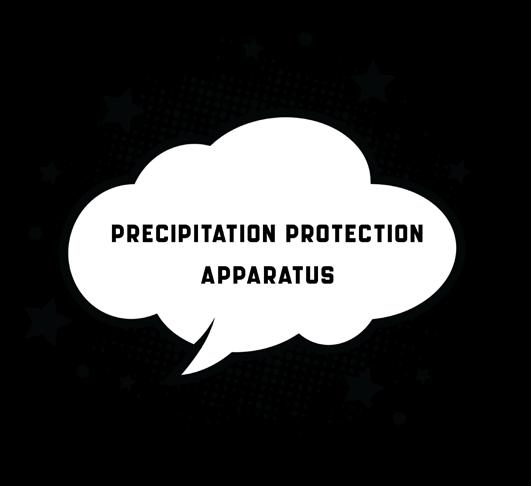

Opinions 39 Design: Afia Zaman
Words:
Musings on Homesickness and Hungarian Christmas Treats
With the arrival of the winter season, I often feel a sense of homesickness that I don’t experience during the rest of the year. Maybe it’s just because my parents’ flat in Budapest is significantly warmer than mine, or maybe the “giving season” makes me particularly miss my friends and family. But to be honest, the biggest reason is probably the food.
When I was a child, winter was my favourite season. We had huge snowfalls, we could go sleighing, make snowmen, and have snowball fights so intense that teachers had to ban us from the playground. When I went home from a day full of snowy adventures, my mum would bake cinnamon rolls and cocoa rolls (“kakaóscsiga” in Hungarian, meaning “cocoa snail”), and make hot chocolate.
Due to global warming, an everincreasing amount of schoolwork, and growing older and wiser, I had to stop these fun activities, but the food, thankfully, remained.
Before Christmas itself, it is tradition to visit an ice rink, fall on my face three times, freeze my fingers off, and then get overpriced mulled wine from the Winter Market to revive myself. After that I spend way too
much money buying unnecessary things for everyone in my family, but it’s fine because I can smell “kürtöskalács” (“chimney cake”) from one of the stalls, and I will soon devour the cinnamon flavoured sugary goodness.
On Christmas, my mom makes “bejgli”, a sweet roll traditionally filled with poppy seeds, chestnut, or walnut. This is usually had as dessert after a main-course fish dish, which can be fish soup (my least favourite) or salmon, for example. Nevertheless, whenever I have Christmas food at home, for a few days I don’t want to go back to Scotland. That feeling quickly dissipates when I remember the numerous human rights violations of the Hungarian government, which will definitely be discussed at Christmas dinner.
The holiday season is a bittersweet time for me. Sometimes I wish that I could spend the rest of the year home with my family and friends from Hungary, but I wasn’t happy there for the first twenty years of my life. Hungary is definitely not the worst country to live in, but it is not the easiest either. Until things change, I have to feel at home away from home.
Luna Jezzard 40 Opinions
Ren Jakab, Design:
Words: Jasmine Patel, Design: Patryk Dybalski
IS CAPITALISM KILLING CITIES?

Historically, cities have served as an epicentre of community and culture. Living in close proximity to friends and strangers alike is hugely beneficial to the human psyche and, globally, life satisfaction is higher in urban areas than their rural counterparts. We are inherently social creatures, and the city allows us to centre connection in our lives. However, the number of people renouncing their city ways for the countryside is increasing all over the world. Why?
Capitalism promotes self-sufficiency: my own car, my own house, my own garden, so big I can’t see anyone else.
“Much of city design in the last few hundred years has been influenced by the overwhelming ‘urge for more’, what we call Capitalism. Regeneration and revitalisation projects have become excuses to remodel areas to serve corporations, or really anything but the people. Take for example, neighbourhoods in the Bronx in New York City being bulldozed for Robert Moses’ superhighway construction in the 1940s, or communities being forced out of King’s Cross in London to make way for a new corporate oasis. Cities are being remodelled to a point where individual people feel redundant in a seemingly well-oiled machine of finance and business interactions.
What happened to the promised epicentres of art and culture that brought so many people to urban areas? Urban design has lost its social spark, human connection is no longer the priority when designing spaces. Much of America, for example, has been designed with the automobile as the primary citizen, leading to losses in public spaces and degradation of those that still hang on. In most cities in America, let alone smaller towns, public transport is not an option and people are reliant on cars to fulfil their daily needs. Privatisation is erasing parks, community gardens and other mixed-use public spaces, undoing the very principle of inclusivity and connection that they stand for.
Individualism has become a plague and societies are getting more and more separate. Capitalism promotes self-sufficiency: my own car, my own house, my own garden, so big I can’t see anyone else. How are cities meant to survive when modern urban design teaches you to yearn for your own private world? Suburbanisation, a phenomenon that emerged in post-war America to house returning soldiers and their families, perfectly demonstrates this individualism. Urban planning needs to return to its roots and put the needs of communities at the forefront of design again before the homogeny of investor-centred spaces crushes the character of cities everywhere.
Opinions 41
Words: Hazel Surtees
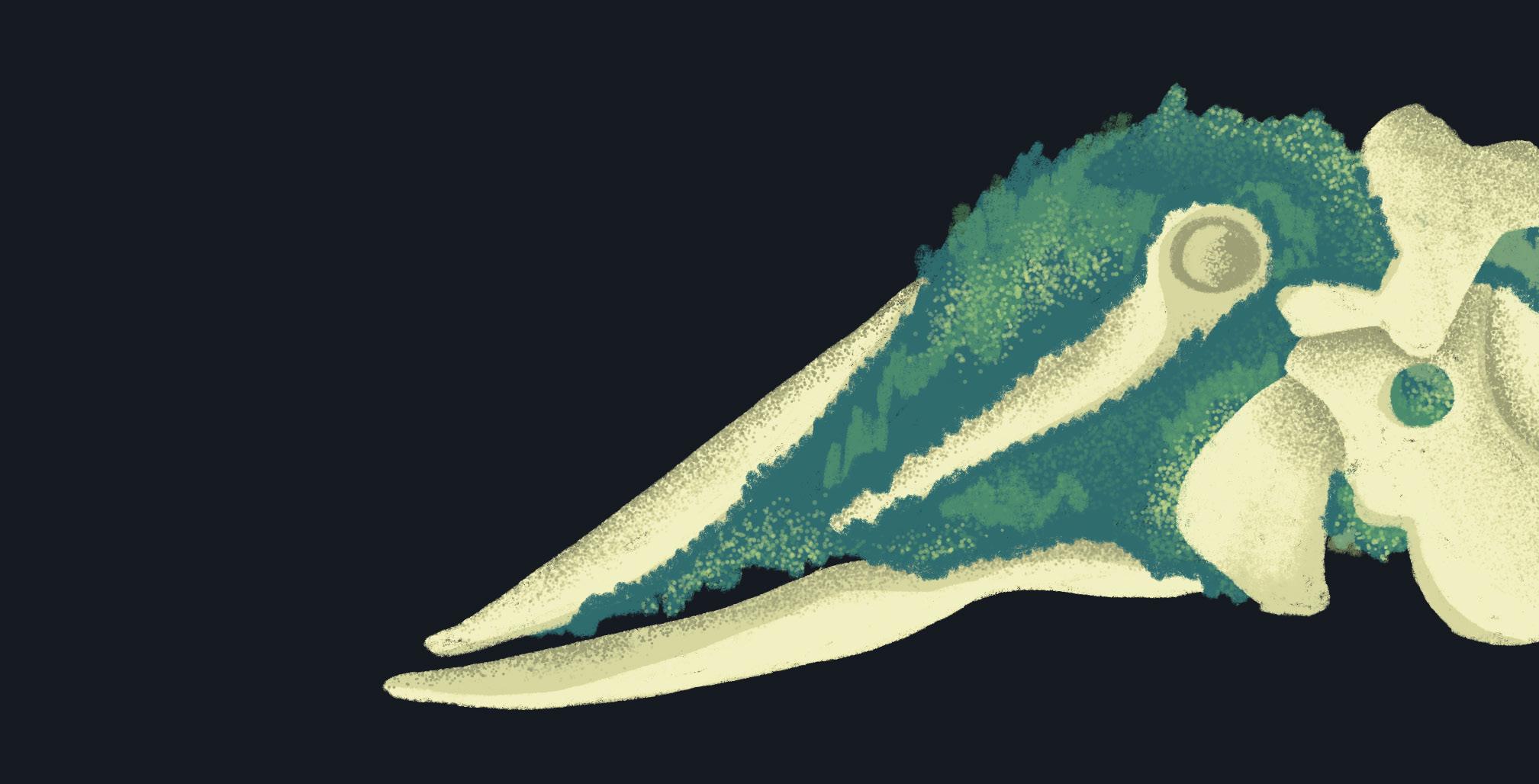
Whale Fall
Festive season approaches, and with it, the promise of a feast. Can you picture it now: a table heavy with platters and dishes, maybe a roast bird in the centre or plates of latkes, laden with shining sauces, billowing steam and seasonal veg, bright compared to the cold outside. There’s a key difference between a dinner and a feast: the table is surrounded by loved ones, and you are dining in style. There will be enough food to provide leftovers for the week, almost more delicious over time.
I’m sure you’ll be near-comatose in a post-dinner nap later. Worth it.
But pause, before you get too hungry. Let me redirect you to another feast, happening a couple thousand miles away. Down where it is deep, dark, and very, very cold. Never mind feasts, there’s almost no life here at all, but stop before you yuck someone else’s yum.
See, there’s a whale fall.
A whale, possibly exhausted on a migratory route, has died and sunk slowly down
the water column. The scene is wintery, sitting at an average of 4°C at the ocean floor. No sunlight reaches these depths, and barely any biomass is present. Food supply is incredibly limited: it’s estimated only 5% of the ocean’s biomass reaches the sea floor, with sinking marine snow (AKA dying plankton and fish poop) having been consumed far above. Yet, a bizarre and diverse set of life remain, adapted to high pressure and low metabolisms. A whale fall prompts a sort-of pilgrimage.
During the first stage, the mobile-scavenger phase, octopi, sleeper sharks, hagfish, brittle stars and crabs move in and rapidly strip the body of soft-tissue. Between 40kg and 60kg of soft tissue can be consumed within a day, and after a few months (at most), the skeleton will be bare.
And yet the feast continues. Whales are unique in having intensely lipid-dense bones, meaning delicious energy is locked inside, if only it can be cracked open. We’re now at the enrichment-opportunist stage, and
Science & Technology
42

evolution has crafted the perfect tin opener. Of particular celebrity is a worm, a far cry from the ones you might find in your garden.
Osedax worms are known as bone eaters. They have evolved almost root-like structures which burrow into the bone, while a fan-like appendage floats in the water, to harvest trailing debris.
Inside the worm’s roots, it has cultivated specialised symbiotic relationships with bacteria which can break down the fats and proteins in the bone matter.
This stage can take from months to years, depending on the size of the whale fall and environmental conditions. In the following sulfophilic stage, thick mats of yellow, pink and black bacteria grow up. These represent an end-stage in the food chain, using sulphur the same way we use oxygen to convert debris nothing else could recognise as food. This stage can last decades
The remains of the whale skeleton continue to play an important role on the sea floor: the final stage, known as the reef stage, sees the colonisation of the bones by coral, worms, and shellfish. This has been observed on a whale fall nearly 5,000 metres deep, estimated to have fallen 10,000 years ago. Certainly, a feast to remember.
Researching whale fall remains challenging. One of the greatest obstacles is simply finding the whales, which involves combing the entire sea floor, hoping to stumble across one. One work around is to instead take whales beached on coastlines out into the water, sinking them with the weight of scrap metal to overcome the gas built up inside the rotting body.
Still, the research is having surprising applications. For example, some of the bacteria involved in breaking down these ice-cold fats are being investigated for their use in cold-water detergents. Imagine that! Running your laundry with bacterial compounds, first found miles under water.
There is a circular idea to it, especially in Dundee: researchers theorise the booming whaling industry of the 18th and 20th century may have not only stripped the oceans of whales, but also of the complex role they played in the ecosystem as whale fall. It’s difficult to quantify the impact left on the ocean ecosystems, especially so far from the ocean surface.
But, perhaps it’s something to keep in mind as you sit down with friends and family, and admire the bounty laid before you. There are dinner guests in the deep ocean, and they are dining in style.
Science & Technology 43 Design: Islay Yeoman
Finding Light in the Darkness

For many of us, winter can be a particularly difficult time of the year; transitioning to darker evenings, colder days, and worse weather can make the season feel rather isolating. Considering this shift from the often pleasantly warm and colourful autumn into the notably harsher winter months, it is hardly surprising that various cultures and religions worldwide celebrate a ‘festival of light’ as winter draws in.
Perhaps the most well-known of these celebrations of light is Diwali, a holiday primarily celebrated by Hindus and Sikhs on the darkest night of the Amavasya moon cycle. During Diwali, many people set off fireworks, hang lanterns, and light candles to represent the triumph of light over darkness, and good over evil. It is also a time of sharing and appreciation between family and friends; sweets and fruits are given as gifts. It is a beautiful celebration and one that was recently honoured in Dundee with a stunning display of lights.
Just as lanterns, fireworks, and candles play a major role in Diwali, many other festivals reflect this key ethos of celebrating light. Saint Lucia Day is celebrated in Sweden on December 13th to mark the return of longer daylight hours as spring approaches and involves wreaths of candles being worn by the eldest daughter of each household. Hanukkah, a greatly important holiday for Jewish people, is commemorated by lighting a menorah with nine candles (this even gave rise to the holiday being nicknamed ‘The Festival of Lights’). And, of course, Christmas, a holiday that many of us look forward to each year, is filled with different forms of light; again, whether it be candles, fairy lights, or even Christmas lights set up in our towns and city centres.
As humans, we are inherently light-seeking creatures. From a scientific standpoint, the effect that different light levels can have on us has been studied extensively. It is welldocumented that adequate light exposure (especially sunlight) can reduce fatigue, increase productivity, and, perhaps most
Science & Technology Words: Bethany McDonald 44

importantly for the theme of this article, massively improve our mental well-being. The shortest day in Scotland this year is December 21st when there will only be daylight from 8:45am until 3:30pm. Throughout November and December, the days gradually become shorter and shorter until this day, which is known as the Winter Solstice. With this in mind, it makes sense why so many of us struggle in these months; with little daylight and the weather becoming even more bitterly cold, it can become difficult to get outside at all. Another issueVitamin D deficiency- comes with this lack of daylight hours. The Scottish Government “recommends that everyone take a daily supplement of 10 micrograms of vitamin D, particularly during the winter months”, as we know that a lack of sunlight (and, by extension, vitamin D!) can have a huge impact on our mental health.
It’s certainly not all doom and gloom though! During the cold and dark winter months, there is light at the end of the tunnel - both proverbially and literally. All of the lightbased holidays and celebrations mentioned earlier in this article mainly aim to lift our spirits by celebrating the light within the darkness, but also by acting as a way of bringing people together.
In my household, Christmas is always a time of showing appreciation for those closest to you. Whenever I think about this time of year, the one word that comes to mind is ‘warmth’ - being around family and friends, sharing stories, exchanging gifts, cooking meals together. For myself and many others, Christmas is a welcome break from the hectic winter schedule of studying, exams, and less-than-ideal weather. Perhaps then, we can think about humans being ‘light-seeking’ in more than one way; we look for literal light, yes, but also the light and happiness that comes from being around those we love and care for.
Even in the darkest and most punishing months of the year, humans come together and find their way to one another. The fact that we celebrate light festivals during winter in so many different cultures worldwide is part of what makes us human; even in utter darkness, we always want to seek out that little bit of light.
As this year rapidly draws to a close, and the holiday season fast approaches, remember to take time to think about how you can bring some more light into your everyday schedule; whether it be wrapping up warm and getting outside for a walk when the sun graces us with its presence, going out for a coffee and a catch-up with a friend, or spending time with family members who you don’t get to see very often. However you celebrate, I hope you have a wonderful time. Happy holidays, and a Happy New Year when it arrives!

Science & Technology 45 Design: Islay Yeoman
Words: Hazel Surtees, Design: Katy Blair

Tackling TB: Dundee scientists fighting the killer cough
From October 2023 to 1st April 2024, Verdant Works is showing an exhibit on Tuberculosis (TB).
“Tackling TB: Dundee scientists fighting the killer cough” has been produced in collaboration with researchers from the Welcome Centre for Anti-Infectives Research (WCAIR) and draws on archive footage, patient testimonies, and insights into the world of research to tell the story of TB in the past, present, and future. The familyfriendly exhibition has something for every curious mind, including interactive activities for budding young scientists alongside a refreshingly in-depth exploration of the disease and its impact.
Entry comes with an annual pass to Verdant Works. The exhibit is found in the High Mill space, located beneath the towering steam engine and over-worn cobblestones, which brings you close to the historical context. Information boards, videos, activities, and collected resources lead you through the story of TB in an interactive way. The disease and current treatment practice are introduced with a video by leading researchers based at the University of Dundee, providing an insight into their work.
Did you know Glasgow was the home to one of the largest TB public health campaigns? Initially, they aimed to x-ray 250,000 members of the public for asymptomatic and early cases of TB.Instead, they managed to x-ray 700,000 people!
The exhibition brings to mind our not-sodistant experience with mass testing and disease control, and it’s fascinating to compare the similarities and differences. This, alongside historical testament and opportunities for the public to reflect upon their memories of the BCG vaccine for TB, highlights the immense impact TB has had on Scotland.
The latter half of the exhibition brings us back to the present, describing the global impact of TB and the long and intensive course of treatment. It benefits from a collaboration with Ninewells, sharing a recorded conversation between a recovered-TB patient and his doctor. Throughout the space are opportunities for children to get involved, with an interactive game exploring the drug-discovery process and lab coat try-ons.
Overall, the exhibition provides a brilliant overview of TB, diving into fascinating detail of its impact through time, supported by the reflections of researchers and medical professionals in the field. It’s a worthwhile day out for people of all ages looking to learn something new!
“Tackling TB: Dundee scientists fighting the killer cough” is on display from 7th October 2023 to 1st April 2024. Verdant Works is open Wednesday – Saturday, 10AM – 5PM, and Sunday 11AM – 5PM. Full accessibility information and admission prices can be found online.
Science & Technology
46

Senior Team
Senior Editorial Team
Photography Team


Editor-in-Chief
Roshni Baillie
Dep. Editor-in-Chief
Mariya Georgieva
Creative Directors
Katy Blair
Fiona Howard
Lilian Truong
Website Manager
Benjamin Arthur
Managing Editors
Rachel Goodman
James McLeish

Katherine Donaghy
Patryk Dybalski
Mary Musa
Daniel Somoghi
Senior Feature Editor
Bronte Chalmers
Alexander Stewart
Afia Zaman
Illustration Team
Section Editors & Publishing

Ariane Legradi
Marie Pape
Phiphi Tran
Emma Vind
Cover Artist


Publishing The Magdalen is published by Dundee University Student Association (DUSA).
The festive Cover Art for Issue 103 was done by one of our stunning Illustrators; Marie Pape
our team!
you're a UoD or Abertay student and have a passion for design or
we’d
to
you! TheMagdalenMagazine @themagdalenmag
Connect with us Online!
@themagdalenmag TheMagdalenMagazine Join
If
writing,
love
hear from
www.themagdalen.co.uk
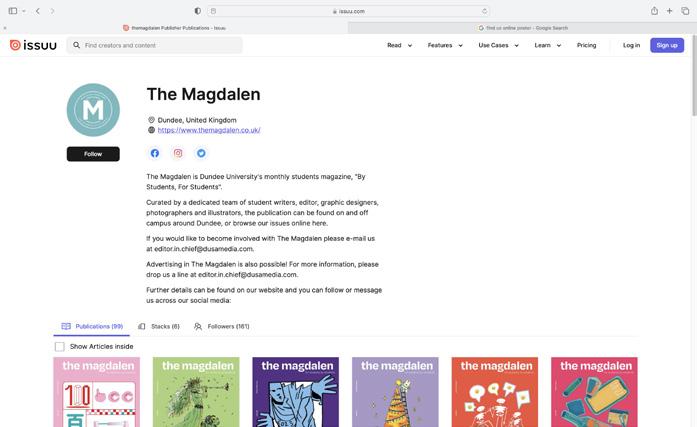


Love the magdalen?
on Campus? No Worries! Never miss out on a second of the action. Find EVERY SINGLE issue of The Magdalen EVER! 100% FREE! issuu.com/ themagdalen @
Not

What's on?
Go Global Fair 2024, provides students and graduates the opportunity to meet with employers offering global opportunities.
15th February
1st February UoD Volunteering & Work Experience Fair, allows students and graduates to meet a range of organisations offering volunteering opportunities.
6th7th January & 3rd4th February
ScrapAntics Loose Parts Play Session
At ScrapAntics we are passionate about play and its enormous importance to effective life-skills learning and community cohesion. We use Loose Parts - recycled resources that can be played with, built and broken in a multitude of ways.

















































 Design: Fiona Howard
Design: Fiona Howard














































